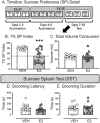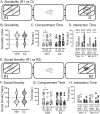Chronic 17β-estradiol treatment improves negative valence, anhedonic profile, and social interactions in ovariectomized, middle-aged female rats
- PMID: 40672384
- PMCID: PMC12263923
- DOI: 10.3389/fnbeh.2025.1553501
Chronic 17β-estradiol treatment improves negative valence, anhedonic profile, and social interactions in ovariectomized, middle-aged female rats
Abstract
Women experience depression at nearly 2-fold higher rates than men, with middle-age during the menopausal transition being particularly vulnerable. Preclinical studies commonly focus on young adult or aged subjects and/or rely upon a few behavioral tasks. Given the highly variable and heterogenous nature of depression, the current study implemented a behavioral battery to assess whether estradiol (E2, endogenously expressed in women and rats) would improve depressive measures using the Research Domain Criteria (RDoC) for negative valence, anhedonia, sociability, and anxiety in early middle-aged, ovariectomized (OVX) female rats. F344-cdf rats were OVX and injected daily with E2 (3 μg/ml, or oil). Behavioral testing began after 14 days of injections, which continued throughout the study. E2 improved the depressive profile when using a composite metric for negative valence (immobility on the forced swim task, FST), anhedonia (duration to initiate grooming following sucrose splash and latency to initiate grooming with sucrose), sociability (time interacting toward a novel conspecific), and novelty-induced anxiety (time spent investigating marbles). Interestingly, FST immobility significantly and positively correlated with sucrose preference to show they were opposingly related: higher immobility on FST corresponded to more sucrose ingested. Also, time spent in a chamber with a novel conspecific was less informative than time directed at the conspecific. Other tasks, such as the marble bury test showed some hoarding behavior. These nuances revealed difficulties in assessing behaviors within and across studies, but overall showed that E2 improved the depressive-like syndrome (DLS) in middle-aged females based upon the RDoC.
Keywords: Forced Swim Test (FST); anhedonia and sociability in middle-age depression; anxiety; estrogen; estrogen improves negative valence; sociability; sucrose preference.
Copyright © 2025 Conrad, Peay, Sladkova, Kim, Donnay, Acuña and Whittaker.
Conflict of interest statement
The authors declare that the research was conducted in the absence of any commercial or financial relationships that could be construed as a potential conflict of interest.
Figures







Similar articles
-
Corticosterone disrupts spatial working memory during retention testing when highly taxed, which positively correlates with depressive-like behavior in middle-aged, ovariectomized female rats.Horm Behav. 2024 Aug;164:105600. doi: 10.1016/j.yhbeh.2024.105600. Epub 2024 Jul 14. Horm Behav. 2024. PMID: 39003890 Free PMC article.
-
The Black Book of Psychotropic Dosing and Monitoring.Psychopharmacol Bull. 2024 Jul 8;54(3):8-59. Psychopharmacol Bull. 2024. PMID: 38993656 Free PMC article. Review.
-
Sexual Harassment and Prevention Training.2024 Mar 29. In: StatPearls [Internet]. Treasure Island (FL): StatPearls Publishing; 2025 Jan–. 2024 Mar 29. In: StatPearls [Internet]. Treasure Island (FL): StatPearls Publishing; 2025 Jan–. PMID: 36508513 Free Books & Documents.
-
A rapid and systematic review of the clinical effectiveness and cost-effectiveness of paclitaxel, docetaxel, gemcitabine and vinorelbine in non-small-cell lung cancer.Health Technol Assess. 2001;5(32):1-195. doi: 10.3310/hta5320. Health Technol Assess. 2001. PMID: 12065068
-
Intravenous magnesium sulphate and sotalol for prevention of atrial fibrillation after coronary artery bypass surgery: a systematic review and economic evaluation.Health Technol Assess. 2008 Jun;12(28):iii-iv, ix-95. doi: 10.3310/hta12280. Health Technol Assess. 2008. PMID: 18547499
References
LinkOut - more resources
Full Text Sources
Miscellaneous

